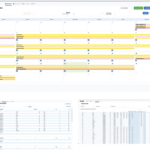Their Ron StageMaster Overload Detection System is Designed to Guard Against Truss Collapse
Their load monitoring and overload prevention products might never get to shine in the spotlight, but they seem to be everywhere these days: from the Orlando Conventional Hall to the Sydney Opera house; in the inventory of PRG and Kish Rigging; in the shows of Cirque du Soleil and Disney.
They are Eilon Engineering, specializing in the development of advanced load and force measurement systems for industrial applications such as load cells, crane scales, dynamometers, and of most interest to PLSN readers, overload/underload detectors. Their Ron StageMaster load monitoring and overload prevention system is being increasingly embraced by the North American live event industry.
While Eilon name might be new to some, the company was established in 1976 and now serves a wide array of customers known for meticulous attention to detail.
“Our wireless load cells have been on the market for more than two decades, continuously tested and approved by customers like NASA, Boeing, Lockheed Martin, the U.S. Air Force, and many others,” says Ilan Bahar, Ron StageMaster product manager.
The Ron StageMaster product range includes a wired option for fixed installations or a completely wireless system for more temporary applications like touring.
The wireless system option requires no cables at all, and offers a wireless transmission range of up to 600 feet standard, and, optionally, up to 2/3 mile (1 km). Batteries enable the load-monitoring units to be always on, monitoring continuously over a 4,000-hour span, and the system is designed with the ability to use a variety of frequencies and multi-channel transmission to sidestep problems with wireless interference.
No Shortcuts
With clients like NASA, the company has built a reputation for putting safety above all else. “We don’t take any shortcuts,” says Bahar, a certified industrial and business engineer with 20 years of experience in IT, logistics, and project management. Noga Eilon-Bahar, vice president of business development, notes that Ilan Bahar has also served as a member of R&D teams in heavy industry and infrastructure projects.
“We have been designing and manufacturing load cells for 30 years and in live events for eight years,” Ilan Bahar continues. “A lot of experience and expertise is built into our load cells. We are not just reacting to the recent growing demand and starting to study the material. We were one of the first to offer load cells for the live events.”
For clients like Germany-based rigging company Dart GmbH, which have used the Ron StageMaster on tour for Rammstein’s massive set elements, the system serves as an invaluable aid in safeguarding large grids with multiple loading points and dynamic loads. On one of the band’s recent tours, there were 15 two-ton motors lifting 20 truckloads of gear; each of those motors was equipped with the load-monitoring devices.
Data vs. Guesswork
Along with the advantages of real-time data vs. a risk-prone blend of calculations and guesswork, clients appreciate the system’s ease of use. Other advantages include the ability to assure venue managers that the total load will be within the venue’s safety limits and the potential for lower insurance premiums.
The history of how the Ron StageMaster system came about starts in 2001, when the Hilton Tel Aviv called Eilon Engineering to assist in monitoring the loads at a live event. “We used our existing industrial model for this project, and it went really well,” Bahar says. “So then we started studying this interesting application and were surprised to realize that there is no legal obligation to monitor loads in shows, although often there are tens or hundreds of people below many tons of heavy loads, and especially in light of the unpredictable load distribution problem.
“This was even more strange in light of the accidents that occasionally happen in live events, some of them are fatal accidents, that in very high likelihood overload by itself or overload combined with weather conditions caused them.”
As Bahar explains it, the problem is unpredictable load distribution. Due to the phenomena in physics of “statically indeterminate structures,” each time there are more than two loading points on a truss or more than three loading points on a structure, the load distribution, practically, cannot be calculated.
“As a result, some of the hanging points might be overloaded and others carry a small part of the load, while the truss by eye still appears to be balanced. For this reason, continuous load monitoring, from the beginning of the setup, through rehearsals, the show itself, and then dismantling, is crucial.”
The Eilon design team then applied their experience and knowledge in load cells to a new system targeting the live events industry’s needs, and, in 2006, launched their first Ron StageMaster model. They were honored with a 2007 LDI Innovation Award and a 2008 PLASA Innovation Award. While those honors and a growing client list were certainly welcomed, they continued to promote safety.
Continuing Education
“We spent the following years in intensive education activities to increase awareness to the problem of unpredictable load distribution and the importance of load monitoring,” Bahar says. “We felt then, and we still feel, that this is an important and challenging mission, and whenever we have the chance to conduct a training, presentation or hands-on demonstration about the danger of unpredictable load distribution and the importance of load monitoring, we try not to miss it.”
And the company is continuing to develop new technologies. “We are always investing in continuous R&D in order to harness the latest technologies and incorporate them into our systems in order to make them even safer, and keep our technological edge,” says Bahar.
For more information, go to www.eilon-engineering.com.


